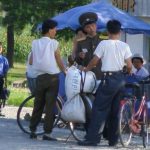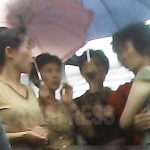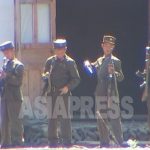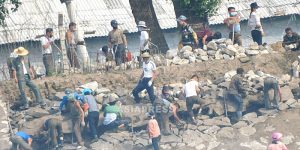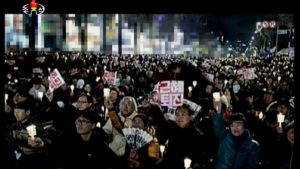
Korean Central Television, a state-owned television service in North Korea, broadcasted the pixelated image of the rally calling for South Korean President Park Geun-hye to step down since November.
It happened in a talk show called “The traitor, Park Geun-hye, must stop playing the deceptive “political game” and immediately resign” on the third of December.
The TV show broadcasted around 20 images to introduce the situation of the rally and related gatherings for 13 minutes. However, high-rise buildings in the central Seoul and the bronze statues of Commander Yi Sun-sin and King Sejong at Gwanghwamun Square were all pixelated.
(Commander Yi Sun-sin is famed for his victories against the Japanese navy during the Japanese invasion of Korea by Hideyoshi Toyotomi in the 16thcentury. King Sejong created the Korean alphabet, Hangul, in the 15th century.)
Korean Central Television, operating under the regime, unnaturally pixelated the images to hide the development of South Korea while actively propagandizing the growing anti-Park Geun-hye sentiment among South Korean people.
Commander Yi Sun-sin and King Sejong are regarded as heroes in North Korea as well, about whom students learn at school. However, regarding bronze statues, only those of Kil Il-sung, Kim Jong-il, and his mother Kim Jong-suk can be built in the city central. In North Korea, people can revere only three of them as “the peerless great person”.
However, it is unrealistic that the bronze statues of the heroes around 400 to 500 years ago located in Seoul would have a significant influence on the people in North Korea. Presumably, censorship personnel in the talk show have pixelated the images with precaution since they overly surmised the opinion of the government, for fear of being criticized later on.
◆ In the 1980s, videos of a rally let the ordinary people in North Korea how prosperous South Korea was.
In the 1980s, large-scale protests calling for the anti-dictatorship and the democratization got momentum. North Korea frequently broadcasted the news about it. They intended to domestically propagandize that the masses in South Korea were against the military dictatorship and the government lacked the legitimacy”.
However, North Korean people focused on the different information in the videos of protests. They started to guess how high the South achieved the economic development, by looking at clothes, sceneries of the city, and the number of cars on the street.
Regarding the new “finding” from a video of the rally in the 1980s, a North Korean defector in Seoul described that “I had been taught that the people in South Korea were repressed and starving under the military fascist government. However, young people in the video wore sophisticated clothes and there were no scrawny people at all. The high-rise buildings stand along the streets in the city. The rumor, “South Korea is affluent,” that I had vaguely heard was verified, I thought”.
Related Article: [Video Report] Fleeing back alley vendors by cracking down
Following the inflow of the information since the 2000s, North Koreans, regardless of the age and the place of residence, understand as a commonsense that South Korea has achieved the economic development. Some people even feel the sense of admiration and pride. It seems too late to blur out the buildings and statues, having no effect on the citizens. (ISHIMARU Jiro)
 * Editor’s notes on North Korean reporters
* Editor’s notes on North Korean reporters
ARCHIVE(pdf) >>
DPRK MAP >>
